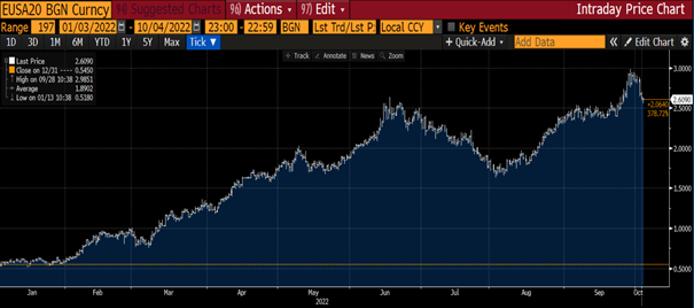
02 February 2023 | 6 min. readingtime
The development of the new issue premium
Today, investors want to be compensated for the increased uncertainty. Factors causing that uncertainty affect the new issue premium, among other things.

02 November 2022 | 3 min. readingtime
The financial markets will be dominated by volatility in 2022. This applies to the stock markets, but certainly also in the field of capital market interest rates and thus the bond markets. Periods of sharp rises in interest rates, alternating with a decline in the summer months, after which interest rates rose sharply again. These interest rates obviously have an effect on the value of bonds, but certainly also on the market value of derivatives portfolios. And thus also on the so-called collateral management. The day-to-day process whereby parties exchange collateral on a daily basis to manage counterparty risk.
Parties can use derivatives, including interest rate derivatives, to reconcile assets and liabilities. Fixed interest rates are exchanged for variable interest rates and vice versa to manage interest rate risk. After closing, the market values of derivative contracts move along with changes in market interest rates. This market value change is nowadays exchanged on a daily basis, the so-called Variation Margin. The counterparty risk is thus managed if a default occurs with the counterparty. Variation Margin is exchanged in the form of cash and nowadays exchanged on a daily basis in line with regulations.
Since the credit crisis in 2008, parties that hedge against falling interest rates have received a lot of cash collateral. The market value of the derivatives has risen sharply due to the continuously falling interest rates. However, now that interest rates are rising, this has the opposite effect, resulting in cash outflow for falling market values.
Below is an overview of the 20-year Swap rate development that shows a sharp increase in 2022:

The development of the 20-year Swap interest rate will be volatile in 2022 and on balance will show a sharp rise with an interim decline. With outliers of interest rate rises or falls of more than 15 basis points in one day, the markets are in full swing. This volatility presents collateral managers with a challenge to continuously manage the inflow and outflow of liquidities. They must be able to continuously adjust the positions for cash collateral calls. In the United Kingdom, this has resulted in the necessary stress and action by the central bank.
A large change in the value of the hedges can lead to substantial deposits or receipts (margin calls). Having sufficient liquidity, a good asset mix with sufficient liquid assets and instruments with which temporary cash can be created are essential. With the volatility in interest rate markets, its importance has increased further. The use of repo markets (with temporary lending of liquid assets) can also offer a solution for short-term significant movements in the rapidly changing interest rate markets. A solid collateral manager must be able to act quickly and be equipped with various instruments to manage positions and make positions liquid. And vice versa with opposite interest rate movements.
And with the geopolitical conditions plaguing the world right now, the actions of central banks to fight inflation, and increasing regulations on mandatory collateral exchange, this becomes all the more important to stay in control at all times.

02 February 2023 | 6 min. readingtime
Today, investors want to be compensated for the increased uncertainty. Factors causing that uncertainty affect the new issue premium, among other things.

07 July 2022 | 6 min. readingtime
These are turbulent times for financial markets. We are going through historical changes in several ways. What is the effect of current economic developments on corporate bonds?

10 November 2021 | 2 min. readingtime
October 2021 was a particularly good month for European and US stock markets, but less so for Asian stocks and emerging markets. Meanwhile, long-term interest rates continued to rise.